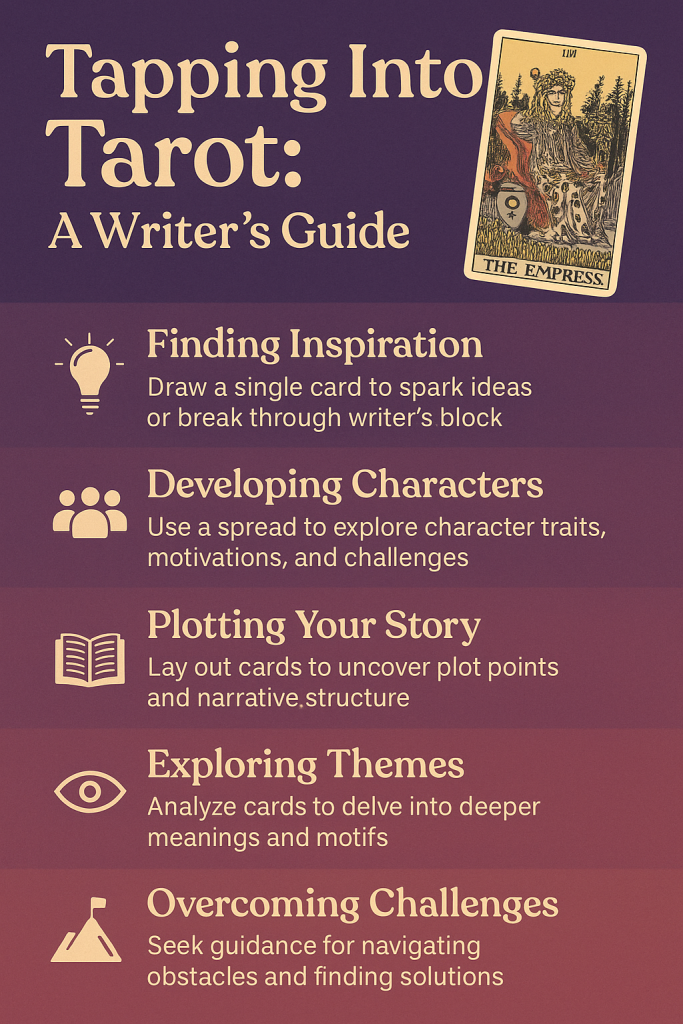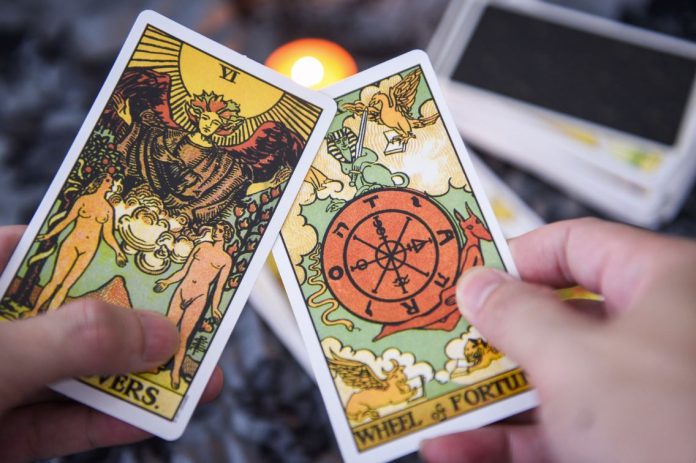Introduction: Writing and the Hidden Language of Tarot
Every writer has faced it: the mocking glare of the blank page. You sit down with coffee in hand, pen ready, or cursor blinking, and suddenly your ideas vanish like smoke through a window. Writer’s block is not just frustrating—it can feel like betrayal by your own mind. What if, instead of forcing your way forward, you reached for a deck of tarot cards and let them guide you?
Tarot, often misunderstood as fortune-telling, is in truth a centuries-old system of archetypes and symbols designed to spark intuition. Just as a novelist strings together images and metaphors, the tarot deck weaves storylines through its imagery. This is where the overlap between writing and psychic tools becomes powerful: a tarot card can unlock a scene, inspire a metaphor, or even birth a brand-new character. Imagine pulling The Fool and suddenly seeing your protagonist not as stuck, but as someone on the edge of an adventurous leap. That’s not superstition—it’s creative ignition.
This article isn’t about replacing your craft with mysticism. It’s about adding another tool to your creative toolbox, one that many writers secretly use. Your next story, essay, or even screenplay could be hiding inside a deck of cards.
The Overlap of Writing and Divination
Writers and psychics are more alike than they seem. Both work with symbols, both interpret hidden meanings, and both translate complex ideas into language. Tarot cards are essentially storytelling prompts that come packaged with centuries of myth and archetype. Each card is a miniature painting, alive with emotion and narrative tension.
Think about it: The Lovers isn’t just about romance—it’s about choice, temptation, union, and conflict. The Tower isn’t just catastrophe—it’s transformation through destruction. Writers who look at these cards don’t see fate—they see plot points, character arcs, and metaphors ready to be woven into words.
Carl Jung, who integrated archetypes into modern psychology, believed tarot tapped into what he called the collective unconscious. That same principle makes tarot fertile ground for writers: it gives you raw material from a shared human mythos that readers instinctively recognize. It’s not surprising that Jung’s theories of archetypes are still widely discussed today in creative and psychological circles (PositivePsychology.com; StudioBinder).
A novelist isn’t so different from a tarot reader: both invite others to see new perspectives. When you shuffle the deck before writing, you’re not predicting your next chapter—you’re collaborating with your subconscious to bring it out of hiding.
Using Tarot as a Daily Writing Ritual

The act of shuffling a tarot deck before writing might seem whimsical, but it’s actually grounding. Think of it like stretching before a run. Each shuffle clears the mental clutter, each cut of the deck resets your energy, and the card you pull becomes a compass for your creative session.
Some writers use a single-card draw as their “theme of the day.” For instance, if you draw The Moon, it might encourage you to lean into mystery, dreamlike imagery, or even unreliable narrators. If you pull The Chariot, maybe today’s focus is on momentum and conflict. The point isn’t whether the card “predicts” your writing—it’s that it gives your imagination a starting point.
Take the example of a journalist working on a deeply personal essay. Staring at her outline, she feels paralyzed by vulnerability. She pulls The Moon, a card often associated with illusions, hidden truths, and subconscious fears. Instead of retreating, she reframes her essay as an exploration of uncertainty itself. That one card shifts her hesitation into direction.
This ritual also doubles as mindfulness. By slowing down, you invite intuition into the room, reminding yourself that creativity is not just a brain exercise—it’s an energetic one. This echoes what researchers have noted about rituals in creativity: daily symbolic practices enhance focus and reduce anxiety (Psychology Today).
Archetypes as Storytelling Catalysts
The Major Arcana cards in tarot are like a ready-made cast of archetypes. Writers can use them to craft characters, conflicts, and themes. Here are a few examples:
The Fool: The innocent hero, the one who steps into the unknown with curiosity. Perfect for the start of a novel or screenplay.
The High Priestess: Keeper of secrets, a character who embodies mystery and depth. Ideal for guiding protagonists through uncertainty.
The Tower: Cataclysm and transformation. A brilliant metaphor for sudden upheaval in a plotline.
The World: Resolution, integration, and fulfillment. This card can inspire the ending of a story, where all threads come together.
One novelist shared that she was stuck in the middle of her draft, unsure how to jolt her protagonist into change. After pulling The Tower, she realized her main character’s safe life needed to collapse before true growth could happen. That one card inspired the dramatic scene that became the emotional heart of her book.
Even nonfiction writers can benefit. Suppose you’re writing a business blog post about resilience. Drawing Strength could inspire you to frame the piece around inner courage rather than external metrics. Suddenly, the article feels human instead of corporate.
Psychologists often emphasize the role of archetypes in communication—these symbols resonate across cultures and time (PositivePsychology.com). Writers who use tarot tap into this universal language, making their stories more compelling without even realizing why.
Tarot for Nonfiction Writers
Tarot isn’t just for novelists or poets. Essayists, journalists, and bloggers can use the deck as a way to frame abstract topics through metaphor. Where logic stalls, imagery opens new paths.
Say you’re writing a self-help piece on overcoming burnout. Drawing The Star might inspire you to structure your article around renewal and hope, using the imagery of light breaking through darkness. Suddenly, the article shifts from being clinical to being deeply human.
A nonfiction writer could also draw Justice when working on a piece about ethics or accountability. Instead of starting with dry statistics, she might begin with the archetypal idea of scales in balance, which draws the reader in through story before delivering the facts.
Writers in education, business, and even science communication have found that tarot imagery provides fresh metaphors that make dense subjects relatable. Psychologists note that the unconscious often communicates through imagery (Psychology Today), which is why tarot can enrich nonfiction writing as much as it does fiction.
Case Studies: Writers Who Quietly Use Tarot
While not every writer will admit to it, tarot has quietly influenced creative literature for centuries.
Italo Calvino famously wrote The Castle of Crossed Destinies, a novel structured entirely around tarot cards. Each card pulled by characters created the next chapter of the story, blending chance with narrative genius.
Sylvia Plath, known for her fascination with occult imagery, often infused her poetry with symbols that mirror tarot archetypes—The Moon, Death, and The Hanged Man appear as metaphors throughout her journals.
In the present day, creative writing workshops increasingly introduce tarot spreads to spark student stories. A memoirist once shared that she pulled Death while drafting her book. Instead of being spooked, she realized the memoir needed a chapter about endings—divorce, loss, and reinvention. That became the most powerful section of her manuscript.
A screenwriter recounted drawing The Lovers while struggling with a romantic subplot. Instead of writing cliché passion scenes, he reframed the relationship around choice and inner conflict, making the love story resonate with complexity.
This quiet lineage of writers turning to tarot demonstrates its staying power. From the avant-garde experiments of Calvino to the blog posts of modern writers, the deck continues to be both a mirror and a muse.
How Tarot Unlocks Subconscious Blocks
When you’re stuck, it’s often not because you lack skill—it’s because your subconscious is holding onto something unspoken. Tarot is one of the few tools that helps you access that hidden material without overthinking.
Psychologists call this “pattern recognition.” When you pull a card, your brain begins making connections between the imagery and your own situation. That’s why a card feels so “accurate.” It isn’t random—it’s your subconscious leaping at the chance to communicate.
Carl Jung described this in his work on archetypes and the collective unconscious. He saw tarot as a mirror reflecting the universal patterns that shape human thought. For a writer, this means every card is a prompt from your inner storyteller, not an external oracle. Modern creative psychology backs this up: studies show that randomness—whether through word lists, dice rolls, or tarot draws—forces originality by shaking up habitual thinking (StudioBinder).
Take the example of a graduate student struggling to outline her thesis. She pulls The Hermit. At first, she laughs—it’s just a cloaked figure with a lantern. But then she realizes her project isn’t about flashy data; it’s about deep reflection on overlooked texts. The card gave her subconscious permission to embrace a quieter, more authentic angle.
Tarot works because it reminds you: the answers aren’t “out there”—they’re already within you.
Tarot Spreads Designed for Writers
If a single card can spark an idea, imagine what a spread of three or five can do. Writers can design tarot spreads tailored to their creative needs. Here are a few to try:
The Daily Muse (1 Card)
Shuffle your deck and pull one card. Use it as the theme for today’s writing session. If you draw The Fool, maybe your blog post takes a leap into an unexplored subject.The Plot Arc Spread (3 Cards)
Card 1 = Beginning, Card 2 = Middle, Card 3 = End. Pull three cards and outline a story based on their imagery. For example, The Magician → The Tower → The World might create a story of ambition, collapse, and ultimate integration.The Character Challenge (5 Cards)
Card 1 = Who they are, Card 2 = Their desire, Card 3 = Their obstacle, Card 4 = Hidden strength, Card 5 = Resolution. A writer once drew The Lovers as desire and The Devil as obstacle—suddenly the subplot of toxic attraction wrote itself.The Essay Frame (4 Cards)
Card 1 = Opening metaphor, Card 2 = Core problem, Card 3 = Resolution, Card 4 = Takeaway. This spread works beautifully for opinion pieces or blogs where structure feels elusive.
Try this: Next time you’re blocked, pull a spread and free-write for ten minutes on what you see. Don’t force it—just let the archetypes speak. You might be shocked at how coherent the draft feels afterward.
Avoiding Writer’s Burnout with Tarot
Burnout doesn’t always show up as exhaustion; sometimes it arrives disguised as boredom, procrastination, or the sudden belief that your ideas aren’t “good enough.” Tarot can help here, not as a productivity hack, but as a form of emotional self-care.
When you pull a card during a season of burnout, you’re not asking, “How do I force myself to write?” Instead, you’re asking, “What do I need to restore balance?” For example, drawing Temperance could be a reminder to blend discipline with rest. The imagery of water flowing between two cups becomes a metaphor for pacing yourself—balancing deadlines with downtime.
One blogger, overwhelmed by constant content schedules, pulled The Hanged Man. At first, she groaned—the card looked like stagnation. But after reflection, she realized it symbolized a pause that brings clarity. She took a week off, reframed her niche, and returned with ideas that resonated more deeply with her audience.
The tarot, in this sense, doesn’t push you harder—it reminds you of your humanity. Creativity thrives in cycles of effort and rest. And unlike rigid productivity apps, tarot meets you with compassion.
When to Work with a Professional Psychic for Writing Guidance
There are times when self-reflection isn’t enough. Just as athletes hire coaches, writers sometimes need an outside perspective to see what they can’t. That’s where professional psychics can offer surprising value.
A psychic session isn’t about predicting your book deal—it’s about uncovering the emotional and energetic blocks holding back your creativity. For example, a poet might repeatedly pull cards pointing to grief, but dismiss the theme in her drafts. A psychic could highlight that avoidance, encouraging her to write through the grief instead of around it. That single reframing could unlock her most authentic work.
Online psychic services make this more accessible than ever. Writers who feel creatively stagnant can book a reading, gain clarity on recurring themes, and walk away with a fresh lens for their projects. It’s like having an intuitive editor who sees beneath the surface.
Psychics often describe themselves as “mirrors.” For writers, that mirror can reflect not just your future, but the untold stories living in your subconscious.
Integrating Tarot into a Professional Writing Career
Using tarot for creativity isn’t just a private ritual—it can become part of your professional practice. The key is balance: weaving intuition into your process without abandoning research, structure, or deadlines.
One novelist admitted she pulls a card before sending pitches to editors. If The Magician appears, she interprets it as a reminder to emphasize originality and voice. Another journalist uses Justice as a pre-interview meditation, reminding herself to ask balanced, probing questions. These moments don’t replace skill—they amplify it.
Editors and readers don’t need to know you shuffled a deck before submitting your manuscript. What matters is that your writing carries energy, imagery, and resonance. By blending tarot-inspired intuition with craft, you cultivate a unique voice. In an age where content can feel mechanical, intuitive writing stands out.
Tarot also strengthens resilience in a professional career. Rejections are inevitable, but seeing them through the archetypal lens of The Wheel of Fortune reframes them: today’s “no” is part of a larger cycle. That mindset keeps you steady, reminding you that every setback is simply a turn in the story.
Conclusion: From Cards to Manuscript
Tarot isn’t a crystal ball. It doesn’t tell you the exact words to type, nor does it guarantee a bestseller. What it does is far more empowering: it mirrors your inner world back to you, offering symbols and archetypes that stir your imagination.
When you pull a card, you’re not asking the universe to hand you a plot—you’re asking your subconscious to show its hand. And often, that’s enough to banish the blank page. Whether you’re a novelist craving a plot twist, a blogger searching for a fresh metaphor, or a student facing the dreaded first draft, tarot can be a partner in creativity.
Think of it this way: every shuffle is an invitation, every spread a dialogue. Your tarot deck is not predicting your writing future—it’s whispering, “The stories are already inside you.”
Frequently Asked Questions (FAQ)
1. Can tarot cards really help with writer’s block?
Yes, tarot cards act as creative prompts that spark new ideas, metaphors, and character arcs.
2. Which tarot card is best for creativity?
The Magician is often seen as the ultimate creativity card, symbolizing resourcefulness and inspiration.
3. How can I use tarot cards to start a story?
Pull one card and free-write about the image or archetype you see—it often reveals a theme or character.
4. Are tarot cards only for fiction writers?
No. Nonfiction writers use tarot for metaphors, framing essays, and overcoming abstract topic blocks.
5. What tarot spread works for outlining a novel?
A three-card “Plot Arc Spread” (Beginning, Middle, End) is simple and effective for building structure.
6. Can tarot improve poetry writing?
Yes, poets use imagery from cards like The Moon or The Star to create layered symbolic verses.
7. How often should I pull cards for writing?
Many writers use a daily single-card draw, while others prefer spreads for major projects.
8. Is tarot a substitute for writing discipline?
No, tarot is a tool for inspiration, but consistency and practice are still essential.
9. What if I draw a “negative” card like Death or The Tower?
See it as symbolic—Death can inspire themes of transformation, while The Tower sparks plot twists.
10. Can tarot help with academic writing?
Yes, students have used cards to reframe theses, organize chapters, and develop unique perspectives.
11. Do professional authors use tarot?
Yes. Italo Calvino structured a novel around tarot, and many modern authors use it privately.
12. Is tarot useful for screenwriting?
Absolutely—cards help develop characters, conflicts, and even cinematic visuals for scenes.
13. Can tarot help with blog writing?
Yes. Bloggers often pull a card to find a fresh angle on common topics.
14. Is tarot connected to psychology?
Yes. Jungian archetypes overlap with tarot imagery, resonating with readers subconsciously.
15. Can tarot help nonfiction writers avoid clichés?
Yes. Cards inspire unique metaphors that replace overused writing tropes.
16. What’s the simplest tarot ritual for writers?
Shuffle, draw one card, and write for ten minutes about what it suggests.
17. Do I need a special tarot deck for writing?
No, any tarot deck works. Some writers prefer visually rich decks for stronger imagery.
18. Can tarot cards help me find my writing voice?
Yes, tarot reflects your subconscious themes, which strengthens authentic voice.
19. Is tarot suitable for journaling?
Yes. Many people combine tarot with morning pages or reflective journaling practices.
20. How do I integrate tarot into a professional career?
Use it as a private ritual for brainstorming—editors don’t need to know you shuffled first.
21. Can tarot help me write faster?
It won’t speed typing, but it helps generate direction, reducing wasted time.
22. What’s a good tarot spread for character development?
A five-card “Character Challenge Spread” (Who they are, Desire, Obstacle, Strength, Resolution).
23. Can tarot inspire dialogue writing?
Yes, pulling cards for two characters can reveal dynamics and conversational tension.
24. Do I need psychic ability to use tarot for writing?
No, tarot works as a symbolic tool—though psychics may bring deeper layers.
25. Can tarot be used in group writing workshops?
Yes, many workshops use tarot spreads as collaborative prompts.
26. Is tarot a spiritual or creative tool?
It can be both. For writers, it functions primarily as a creative catalyst.
27. What’s the best time to use tarot for writing?
Many writers use it during morning rituals, but anytime inspiration is low works.
28. Can tarot help me finish a book?
Yes, spreads like The World card often inspire endings and resolutions.
29. Is tarot safe for beginners in writing?
Completely. No prior knowledge is needed—just curiosity and openness.
30. Where can I learn more about tarot and creativity?
Resources like Psychology Today and PositivePsychology.com offer insights on archetypes and imagination.





While the method outlined seems unconventional, it appears to offer a mix of introspection and creativity that could be beneficial for writers struggling to get their thoughts down.
It’s interesting how the article integrates tarot reading with writing strategies. The approach seems to blend spiritual guidance with practical advice.
For those open to alternative methods, using tarot cards to combat writer’s block could offer a fresh perspective. The prompts provided by the cards might help in overcoming creative stagnation.
Absolutely enlightening! The use of Tarot cards to overcome writer’s block is both innovative and spiritually enriching. It merges the creative process with intuitive exploration, offering a novel way to tap into one’s inner voice. The detailed card descriptions and their applications are exceptionally well thought out. Bravo!
The suggested use of tarot cards as a tool for creativity is fascinating. Although it may not be for everyone, it offers an intriguing way to engage with one’s writing process.
The idea of using tarot cards to overcome writer’s block is quite unique. The cards seem to provide a structured approach to tapping into one’s subconscious creativity.
Comments are closed.